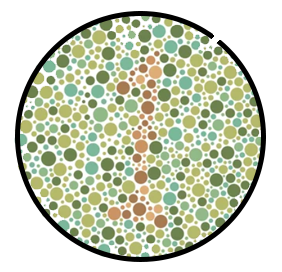Color Blindness
Color Blindness (Color Vision Deficiency)

Color blindness (aka color vision deficiency) is the inability to see certain colors the way most people see them. Usually, problems arise with the differences between red and green, and sometimes blue.
Color blindness usually affects both eyes and does not change throughout life. Color blindness is usually genetic (hereditary) condition, but it can also develop due to trauma to the eye or brain – acquired color blindness.
In the central part of the retina, there are 2 types of cells that perceive colors – rods and cones. Rods respond to light levels, and cones help us perceive three colors: red, green, and blue. The combination of these three colors allows us to perceive the entire color palette.
If some kind of cones is absent, does not work, or does not work correctly, that is, it determines the wrong color, which it should, the person perceives the colors incorrectly. In severe color blindness, all three types of cones are absent. With mild color blindness, there are all types of cones, but one does not work correctly.
Types of Color Blindness
There are different types of color blindness. With a mild color blindness, a person can distinguish colors normally in good lighting, but have slight difficulty in poor lighting. In the most severe form of color blindness, a person sees everything in shades of gray.
Red-green color blindness
Difficulty to differentiate between green and red colors is the most common type of color blindness.
There are 4 types of red-green color blindness:
Deuteranomaly is the most common type of color blindness, when green looks reddish. Usually does not interfere with normal activities.
Protanomaly. Red looks greener and duller. This type also does not greatly interfere with normal activities.
Protanopia, deuteranopia. It is impossible to distinguish between red and green colors.
Blue-yellow color blindness
The blue-yellow type of color blindness is less common than the red-green type. It is difficult for a person with this type of color blindness to tell the difference between blue and green, or between yellow and red colors.
There are 2 types of blue-yellow color blindness:
Tritanomaly. It is difficult to distinguish between blue and green, as well as red and yellow colors.
Tritanopia. It is impossible to tell the difference between blue and green, purple and red, or yellow and pink colors. All colors also appear less vivid.
Complete color blindness
With complete color blindness (monochromaticity), a person is unable to differentiate between colors at all and everything is seen in shades of gray. This type of color blindness is extremely rare.
Genetics
In most cases, genetics is the cause of color blindness. This means that color blindness is inherited from parents and is mainly passed from mother to son.
The red-green type of color blindness affects approximately 8% of men and 0.5% of women. This is because the gene responsible for color blindness is located on the X chromosome.
At conception, a child receives 23 pairs of chromosomes from the parents, that is, 23 from the father, and 23 from the mother. One pair of chromosomes is responsible for the biological sex of a person - the sex chromosome. Women have two X chromosomes, while men have one X chromosome and one Y chromosome.
The gene responsible for color blindness is located on the X chromosome. Since women have two X chromosomes, one chromosome with a “broken” gene is compensated by a second “healthy” chromosome. Therefore, women are less likely to be color blind. However, if a woman has inherited 2 chromosomes with "broken" genes, then she will have color blindness.
A woman with color blindness will pass on an X chromosome with a "broken" gene to her child, since she simply does not have healthy ones. And, if it is a boy, he will also be color blind. And if a girl, then everything will depend on the father. Color-blind father = Color blind daughter, non color blind father = non color blind daughter.
Men only have one X chromosome, so if they have one defective gene, the man will be color blind. A father can only pass on his defective gene to his daughter, which makes her a carrier of the gene (and sometimes color blind). And the sons are passed on the Y chromosome, which has nothing to do with color blindness.
The blue-yellow type of color blindness affects both women and men equally, because it is not transmitted through the sex chromosome.